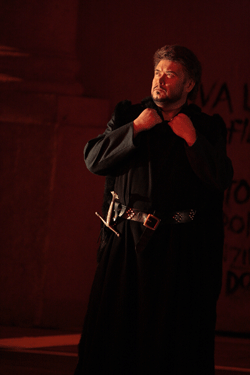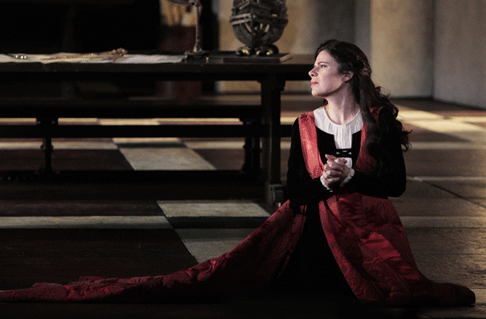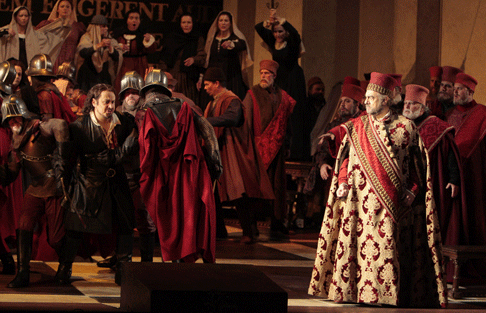![Plácido Domingo as Simon Boccanegra [Photo by Robert Millard courtesy of Los Angeles Opera]](http://www.operatoday.com/sbc5086.gif)
29 Feb 2012
Simon Boccanegra, LA
Sometime everything seems to go right. Just as the Los Angeles Opera Company did last fall, it opened its spring season with a baritonal eponymous opera; this time, Giuseppe Verdi’s Simon Boccanegra.
English Touring Opera are delighted to announce a season of lyric monodramas to tour nationally from October to December. The season features music for solo singer and piano by Argento, Britten, Tippett and Shostakovich with a bold and inventive approach to making opera during social distancing.
This tenth of ten Live from London concerts was in fact a recorded live performance from California. It was no less enjoyable for that, and it was also uplifting to learn that this wasn’t in fact the ‘last’ LfL event that we will be able to enjoy, courtesy of VOCES8 and their fellow vocal ensembles (more below …).
Ever since Wigmore Hall announced their superb series of autumn concerts, all streamed live and available free of charge, I’d been looking forward to this song recital by Ian Bostridge and Imogen Cooper.
Although Stile Antico’s programme article for their Live from London recital introduced their selection from the many treasures of the English Renaissance in the context of the theological debates and upheavals of the Tudor and Elizabethan years, their performance was more evocative of private chamber music than of public liturgy.
Evidently, face masks don’t stifle appreciative “Bravo!”s. And, reducing audience numbers doesn’t lower the volume of such acclamations. For, the audience at Wigmore Hall gave soprano Elizabeth Llewellyn and pianist Simon Lepper a greatly deserved warm reception and hearty response following this lunchtime recital of late-Romantic song.
For this week’s Live from London vocal recital we moved from the home of VOCES8, St Anne and St Agnes in the City of London, to Kings Place, where The Sixteen - who have been associate artists at the venue for some time - presented a programme of music and words bound together by the theme of ‘reflection’.
'Such is your divine Disposation that both you excellently understand, and royally entertaine the Exercise of Musicke.’
‘And there was war in heaven: Michael and his angels fought against the dragon; and the dragon fought and his angels, And prevailed not; neither was their place found any more in heaven … that old serpent … Satan, which deceiveth the whole world: he was cast out into the earth, and his angels were cast out with him.’
There was never any doubt that the fifth of the twelve Met Stars Live in Concert broadcasts was going to be a palpably intense and vivid event, as well as a musically stunning and theatrically enervating experience.
‘Love’ was the theme for this Live from London performance by Apollo5. Given the complexity and diversity of that human emotion, and Apollo5’s reputation for versatility and diverse repertoire, ranging from Renaissance choral music to jazz, from contemporary classical works to popular song, it was no surprise that their programme spanned 500 years and several musical styles.
The Academy of St Martin in the Fields have titled their autumn series of eight concerts - which are taking place at 5pm and 7.30pm on two Saturdays each month at their home venue in Trafalgar Square, and being filmed for streaming the following Thursday - ‘re:connect’.
The London Symphony Orchestra opened their Autumn 2020 season with a homage to Oliver Knussen, who died at the age of 66 in July 2018. The programme traced a national musical lineage through the twentieth century, from Britten to Knussen, on to Mark-Anthony Turnage, and entwining the LSO and Rattle too.
With the Live from London digital vocal festival entering the second half of the series, the festival’s host, VOCES8, returned to their home at St Annes and St Agnes in the City of London to present a sequence of ‘Choral Dances’ - vocal music inspired by dance, embracing diverse genres from the Renaissance madrigal to swing jazz.
Just a few unison string wriggles from the opening of Mozart’s overture to Le nozze di Figaro are enough to make any opera-lover perch on the edge of their seat, in excited anticipation of the drama in music to come, so there could be no other curtain-raiser for this Gala Concert at the Royal Opera House, the latest instalment from ‘their House’ to ‘our houses’.
"Before the ending of the day, creator of all things, we pray that, with your accustomed mercy, you may watch over us."
The doors at The Metropolitan Opera will not open to live audiences until 2021 at the earliest, and the likelihood of normal operatic life resuming in cities around the world looks but a distant dream at present. But, while we may not be invited from our homes into the opera house for some time yet, with its free daily screenings of past productions and its pay-per-view Met Stars Live in Concert series, the Met continues to bring opera into our homes.
Music-making at this year’s Grange Festival Opera may have fallen silent in June and July, but the country house and extensive grounds of The Grange provided an ideal setting for a weekend of twelve specially conceived ‘promenade’ performances encompassing music and dance.
There’s a “slide of harmony” and “all the bones leave your body at that moment and you collapse to the floor, it’s so extraordinary.”
“Music for a while, shall all your cares beguile.”
The hum of bees rising from myriad scented blooms; gentle strains of birdsong; the cheerful chatter of picnickers beside a still lake; decorous thwacks of leather on willow; song and music floating through the warm evening air.
![Plácido Domingo as Simon Boccanegra [Photo by Robert Millard courtesy of Los Angeles Opera]](http://www.operatoday.com/sbc5086.gif)
Sometime everything seems to go right. Just as the Los Angeles Opera Company did last fall, it opened its spring season with a baritonal eponymous opera; this time, Giuseppe Verdi’s Simon Boccanegra.
The production, like the fall’s Eugene Onegin, was not only a first for the company, but happily, starring the company’s director, Plácido Domingo, an even greater artistic success; proving that baritones can be thrilling too.
 Vitalij Kowaljow as Fiesco
Vitalij Kowaljow as Fiesco
Verdi wrote Simon Boccanegra in 1857. Its libretto is based on a play by Antonio Garcia Guttiérrez, which in turn was based on the life of the Genoese plebeian, who was elected first Doge of Genoa in 1339. Verdi’s opera was not well received. However, nearly twenty-five years later the composer revised its music and used a new libretto created by Arrigo Boito. Boito, a writer and genius of another cut, had already composed Mefistofeles, his only opera. Subsequently he wrote the librettos for Verdi’s last and greatest works, Otello and Falstaff.
Simon Boccanegra’s story involves complicated personal and political intrigues. Like Verdi’s other political operas, Macbeth, for example, it is a dark work whose plot is not driven by romantic love. Five of its six major roles are for male voices. Two duets between bass and baritone are extraordinarily powerful. Like Macbeth, even the revised Simon Boccanegra has never achieved the popularity of other Verdi operas. However, it’s a favorite of mine. Its darkness comes not merely from the essentially male cast, its nasty intrigues, or its minimal romance. Musical darkness pervades the entire work from its key signatures, to its melodic lines, to its orchestration. Heartbreak and sorrow permeate the soul of Simon Boccanegra. And Verdi knew that soul intimately. Like Boccanegra, Verdi had lost a wife and daughters almost on the eve of his ascent to power and fame.
Simon Boccanegra begins with a prologue in which the major characters are introduced. Boccanegra is a young corsair, who is inveigled to accept the newly created post of Doge of Genoa by his manipulative power hungry friend, Paolo. We meet Fiesco, the father of Maria, the young woman Boccanegra loves, who has borne his daughter out of wedlock. Fiesco will forgive Boccanegra for this sin, if the corsair can produce that child. But he cannot. He tells Fiesco that little girl has disappeared. Moments later (and we are still in the prologue) just as Boccanegra discovers that Maria is dead, a joyous crowd arrives to declare him the newly elected Doge.
 Ana María Martínez as Amelia
Ana María Martínez as Amelia
The first act begins 25 years later. Now Boccanegra and his daughter, Amelia discover each other. Unhappily, Amelia is in love with a tenor named Adorno. who along with Fiesco and Paolo, each for his own reasons, have united as sworn enemies of Boccanegra. The dramatic highlight of Simon Boccanegra is the magnificent Council Chamber scene with its thundering confrontation between Boccanegra and Paolo. Later, Paolo poisons the Doge. Nevertheless, the opera concludes with just punishment and reconciliation. Paolo is executed. Boccanegra tells Fiesco that Amelia is his granddaughter, and in an extraordinarily moving duet, the two old men, Boccanegra and Fiesco are reconciled. Amelia and Adorno marry. Adorno becomes the new Doge of Genoa. And the dying Boccanegra will find his Maria in heaven. If you can get to the pre-opera talk, Maestro Conlon does a marvelous job of unraveling this sleeve of tsouris, and with music, no less!
The darkness of its preceding scenes make our introduction to Amelia, with its brief moment of joy and high notes the only truly bright moment of the work. Interestingly in Amelia’s first aria of love and longing,”Come in quest’ora bruna” sung as she awaits Adorno, Verdi harks back to the rolling oom pah pah bass of his earlier operas. James Conlon warned his audience that they would cry at the recognition scene and sure enough, I did. But I don’t at every performance of this opera. As I said, sometimes everything seems to go right. And this scene certainly did that Sunday afternoon.
The very strong cast of male singers led by Domingo made this possible. The knock on the state of 71-year old singer’s Boccanegra: that his voice is not deep enough for the role, and raspy besides, may be true, but for the performance I saw, all that was irrelevant. With a dark wig and slimming costume, he strode and sang vigorously as the young Boccanegra. As the gray haired Doge, he was a commanding presence. Domingo has always been an excellent actor, and is unsurpassed in the subtleties his voice whether as tenor or baritone, can express in dramatic roles. The Ukrainian bass Vitalij Kowaljow, who sang Fiesco was a joy to hear if like me you thrill to clear, legato bass singing and long held last low notes. Baritone Paolo Gavanelli and bass Robert Pomakov were equally compelling. Stefano Secco, making his LA debut as Adorno, has a bright tenor voice and happily, his Italian could be understood. Anne María Martínez, a Grammy winner for an album she recorded with Domingo, has a rich lyric voice and produced a genuine trill. Kudos for the chorus, which has a large role in the opera. Maestro James Conlon, who confessed a particular affection for this opera, kept a limpid performance rolling at a brisk tempo.
 Plácido Domingo (right) as Simon Boccanegra, with Stefano Secco (left) as Gabriele Adorno
Plácido Domingo (right) as Simon Boccanegra, with Stefano Secco (left) as Gabriele Adorno
Well, maybe there were two things that weren’t so right: the lighting and the sets created originally by lighting designer Duane Schuler and Michael Yeargan, respectively, for Covent Garden. They seem to have taken the “darkness” of the opera too literally. Both the prologue and final scene were entirely too dim and shadowed. During the prologue it was sometimes difficult to know who was singing. And I found the depth of the sets troubling. Both the prologue, which takes place in a public square and the Council chamber scene, which employ large choruses, were set on comparatively shallow sets, whereas the intimate scenes: the love scene, the recognition scene and Boccanegra’s death were performed with open depths behind them.
But these are quibbles. A great opera, whether joyous or sorrowful, is foremost about music that enters one’s heart and moves it. And Verdi’s Simon Boccanegra does just that.
Estelle Gilson